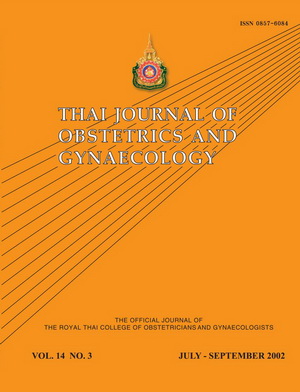Risk Factor for Postmenopausal Osteoporosis: Genetic Polymorphism?
Main Article Content
Abstract
Osteoporosis is a major community health
problem affecting the elderly in most countries.
Increasing life expectancy and changes in life-style
indicate that problems of osteoporosis will markedly
affect a large number of women populations. The
results of large prospective studies have shown that
incidence of almost every type of fracture has increased
in patients with low bone density. The chance for adults
who have a sustained fracture to suffer another one of
a different type is 50 -100%. (1) Incidence rates of hip
fracture are known to increase exponentially with age
in women in most regions of the world. In Asia, the
number of individuals, aged 65 and older, is expected
to increase from 145 million to 894 million. It is
estimated that the number of hip fractures worldwide
will increase from 1.7 million in 1990 to 6.3 million in
2050, and most of the world’s hip fractures will be in
Asia. (2) The measurement of bone mineral density
(BMD) of older women is very important for
assessment of skeletal abnormality, especially in the
area of osteoporotic fracture risk. (3) A low peak bone
mass achieved in adulthood and high rate of bone
loss in peri- and postmenopausal periods are major
determinants for reduced bone density. (4) Both factors
are partly genetically determined. (5-9) Several risk
factors for osteoporosis have been identified (table
1). (10,11) Hypogonadism is an important risk factor for
osteoporosis. Anorexia nervosa, exercise-induced
amenorrhea, chronic illness and premature menopause
are associated with the increase of osteoporosis. A
history of osteoporotic fracture is also indicative of
further fracture. Other risk factors for osteoporosis are
smoking, excessive alcohol consumption, glucocorticoid therapy, low body weight, long-term immobilization and poor calcium nutrition. Among the risk factors
for postmenopausal osteoporosis, genetic factors may
play an important role in determining postmenopausal
osteoporosis.
problem affecting the elderly in most countries.
Increasing life expectancy and changes in life-style
indicate that problems of osteoporosis will markedly
affect a large number of women populations. The
results of large prospective studies have shown that
incidence of almost every type of fracture has increased
in patients with low bone density. The chance for adults
who have a sustained fracture to suffer another one of
a different type is 50 -100%. (1) Incidence rates of hip
fracture are known to increase exponentially with age
in women in most regions of the world. In Asia, the
number of individuals, aged 65 and older, is expected
to increase from 145 million to 894 million. It is
estimated that the number of hip fractures worldwide
will increase from 1.7 million in 1990 to 6.3 million in
2050, and most of the world’s hip fractures will be in
Asia. (2) The measurement of bone mineral density
(BMD) of older women is very important for
assessment of skeletal abnormality, especially in the
area of osteoporotic fracture risk. (3) A low peak bone
mass achieved in adulthood and high rate of bone
loss in peri- and postmenopausal periods are major
determinants for reduced bone density. (4) Both factors
are partly genetically determined. (5-9) Several risk
factors for osteoporosis have been identified (table
1). (10,11) Hypogonadism is an important risk factor for
osteoporosis. Anorexia nervosa, exercise-induced
amenorrhea, chronic illness and premature menopause
are associated with the increase of osteoporosis. A
history of osteoporotic fracture is also indicative of
further fracture. Other risk factors for osteoporosis are
smoking, excessive alcohol consumption, glucocorticoid therapy, low body weight, long-term immobilization and poor calcium nutrition. Among the risk factors
for postmenopausal osteoporosis, genetic factors may
play an important role in determining postmenopausal
osteoporosis.
Article Details
How to Cite
(1)
Panyakhamlerd, K. Risk Factor for Postmenopausal Osteoporosis: Genetic Polymorphism?. Thai J Obstet Gynaecol 2017, 14, 237.
Section
Review


